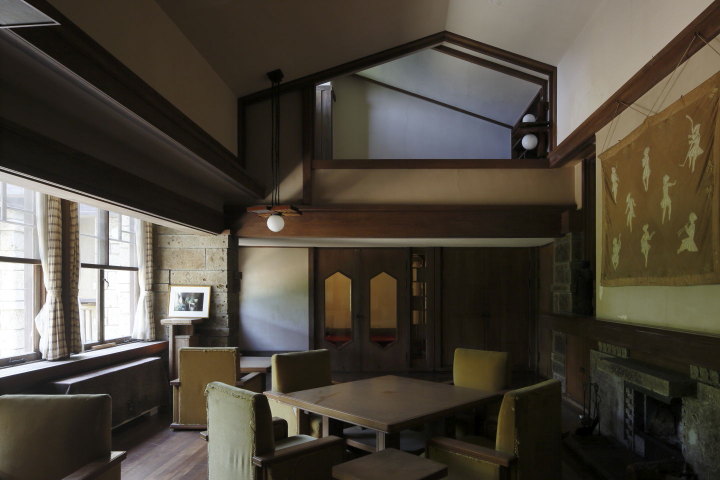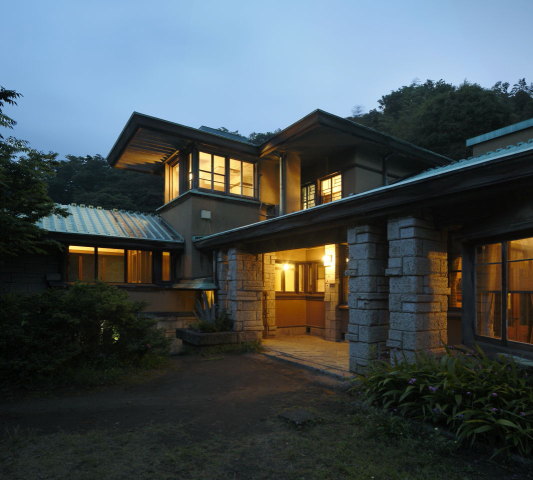ARCHI-CLE
協力 / 住宅遺産トラスト
◆遠藤新(1889-1951)は、フランク・ロイド・ライト(1867―1959)が「東京帝国ホテル」建設(1923年・大正12年竣工)のため来日した折、1917年にスタッフとして関わり、竣工に至るまで主要な役割を果たします。その後も「自由学園明日館」(1922-26年大正11-15年竣工/ライトは1922年夏に米国へ帰国)、「旧山邑家住宅(現淀川製鋼所迎賓館)」(1924年・大正13年竣工)など、ライトが日本において設計にかかわった建築のすべてにおいて、設計から竣工までを実質的に支えました。
「加地邸」は、1889年生まれの遠藤新が39歳の時、1928年に竣工しています。「自由学園明日館」に続き、自ら設計した「自由学園目白講堂」(1927年・昭和2年)、「山邑邸」(ライト基本設計)、甲子園ホテル(1930年・昭和5年/現武庫川女子大学甲子園会館)など、遠藤が質の高い建築を多数設計した充実期の作品で、遠藤が「全一」と考えた、建築から家具、照明器具にいたる総合性を実現したきわめて密度の高い住宅作品です。
加地邸が位置するこの葉山は、快適な気候と豊かな自然に惠まれ、明治の頃から東京の別荘地、保養地として成立し、近くにある御用邸をはじめ、政財界、文化人の素晴らしい邸宅がつくられてきました。これらの建築の存在と記憶は、葉山・逗子・鎌倉・鵠沼という湘南エリアが別荘地として開発され、新たな景観がつくり出された当時の様子を想い起こさせます。
◆建て主の加地利夫と妻の壽(やす)
加地邸の建て主は加地利夫である。加地利夫(1870-1956)は、東京高等商業学校を卒業後、大阪市立商業学校教諭となったが、後に三井物産に入社。1918年(大正7年)にロンドン支店長となり、重役、監査役を歴任、また、大正海上火災保険の重役を務めた。先に竣工した葉山の家に次いで、白金の家を同じ建築家の遠藤新の設計により建てた。
利夫の次男の信(1908―1998)によれば、利夫の妻の壽は、建築に興味があったと見えて、遠藤と打ち合わせしながら設計の変更をしていったという。そして、変更に伴い建築費も当初予算の二倍に達したというのである。また、大谷石などの運搬には近隣の人たちが率先して協力し、道路から敷地まで担ぎ上げた。完成後の家に近隣の人たちをたびたび招いて親交を深めていたという。
(井上祐一 展覧会冊子「加地邸をひらく」より)
竣工日 / 1928年
構造・構法 / 木造(一部RC造)
規模 / 地下1階地上2階建て
敷地面積 / 1,129.52㎡(約341.67)坪
延床面積 / 364.38㎡(約110.22)坪



写真 / 齋藤さだむ
Cooperation / Heritage Houses Trust
◆ Arata Endo (1889-1951)
was involved as a staff member when Frank Lloyd Wright (1867-1959) came to Japan for the construction of the 'Tokyo Imperial Hotel' (completed in 1923) and played a leading role up until its completion. Later, Endo substantially supported the construction of all of Wright's projects in Japan, including 'Jiyū Gakuen Myōnichikan' (completed between 1922 and 1926, Wright returned to the United States in the summer of 1922) and 'Yodokō Guest House' (completed in 1924) from design to completion.
'Kachi-Tei' was completed in 1928 when Arata Endo, born in 1889, was 39 years old. Following 'Jiyū Gakuen Myōnichikan', Endo himself designed 'Jiyū Gakuen Mejiro Kōdō' (1927), 'Yamamura Residence' (Baseline design by Wright), and the Kōshien Hotel (1930, now Kōshien Kaikan). 'Kachi-Tei' was also one of the high-quality architectures which were constructed during Endo's most fruitful period. It is an extremely dense residential creation that achieves a synthesis of everything from architecture to furniture and lighting, which Endo considered to be a 'perfect whole'.
Blessed with a pleasant climate and rich nature, Hayama, where Kachi-Tei is located, has been established as a holiday and resort area of Tokyo. Since the Meiji era, many villas for politicians, business people, and cultural figures, including the nearby Imperial Villa have been built. The presence and memories of these architectures are reminders of the time when the Shonan area of Hayama, Zushi, Kamakura and Kugenuma was developed as an area of vacation residences.
◆ The owner, Toshio Kachi and his wife, Yasu
The owner of Kachi-Tei is Toshio Kachi. After graduating from Tokyo Commercial High School, Toshio Kachi (1870-1956) became a teacher at Osaka City Commercial School and later joined Mitsui & Co. In 1918, he became the manager of the company's London branch. He served as an executive and auditor, as well as as an executive of the Mitsui Sumitomo Insurance Company. Following the completion of the house in Hayama, he built a house in Shirokane, designed by the same architect, Arata Endo.
According to Toshio's second son, Toshio's wife Yasu was interested in architecture and changed the design in consultation with Endo. As a result of these changes, the construction cost was twice the original budget. Besides, neighbours took the initiative in transporting the Ōya stone and other materials from the road to the site. It is said that they often invited their neighbours to the house after it was completed to deepen their relationship.
(Yuichi Inoue, from the exhibition booklet 'Kachi-Tei Open Visit')
Year / 1928
Main Structure and Construction / Wooden (partly Reinforced Concrete)
Size / 2-storey above ground and 1 basement floor
Building area / 1,129.52㎡
Total floor area / 364.38㎡



Photo / Sadamu Saito



